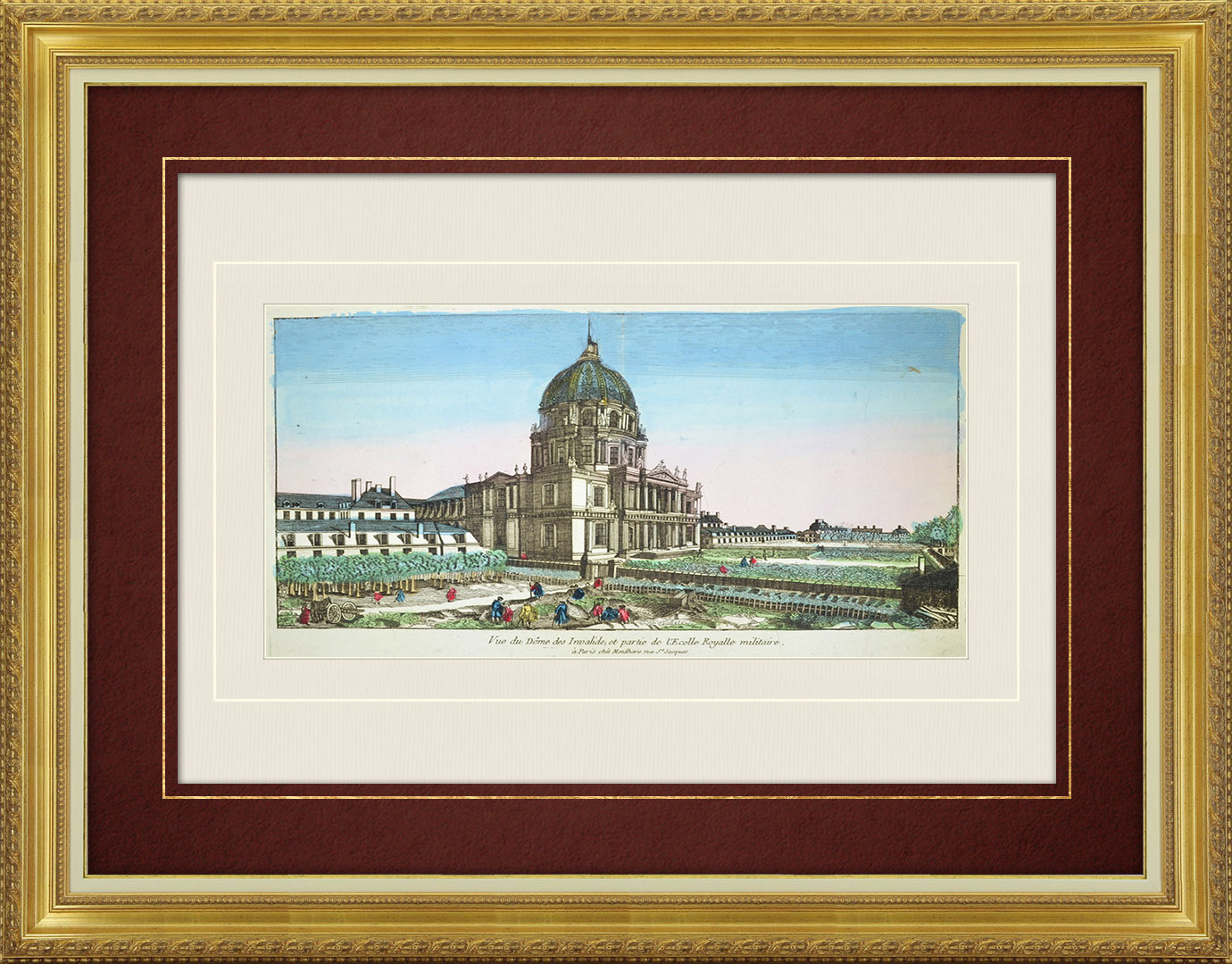
Original title
Vue du Dôme des Invalide, et partie de l'Ecolle Royalle militaire
Mentions
à Paris chés Mondhare rue St Jacques
Description
XVIIIth century optical view in original watercolors. Original copper plate engraving on laid paper with watermark heightened with watercolor at that time. Published by Louis-Joseph Mondhare in Paris circa 1760, depicting a view of the Dôme des Invalides and the Ecole Militaire in Paris (France) .
During the 18th Century, several renowned establishments in Paris, London (England), Augsburg (Germany) and Bassano (Italy) were specialized in the creation of these optical views. They could be viewed alone or through a zograscope, a wooden foot surmounted by a lens which enlarged the image and accentuated the perspective effect. They could also be placed in optical boxes, the spectator then looked inside the box through the lens. This distraction was greatly appreciated in the 18th Century in the salons of the bourgeoisie and the nobility as in the countryside thanks to the hawkers.
These etchings are nowadays exhibited in museums around the world and extremely appreciated by collectors and decorators for their historical interest and their high decorative value.
Museums & Archives
The Bibliothèque nationale de France owns a copy of this optical view in its collections. For more details on this print please consult the site : Vue du dôme des invalide, et partie de l'ecolle royalle militaire
Condition report
Very good state
Find more artworks related to these topics :
This strong water etching is listed in these categories :
Louis XIV initiated the project by an order dated 24 November 1670, as a home and hospital for aged and unwell soldiers: the name is a shortened form of hôpital des invalides. The architect of Les Invalides was Libéral Bruant. The selected site was in the then suburban plain of Grenelle.
The Dôme des Invalides, originally Chapelle royale des Invalides, is a large former church in the centre of the Les Invalides complex.
The dôme was designated to become Napoleon's funeral place by a law dated 10 June 1840. Ousted in 1815 by the allied armies, Napoleon had stayed so popular in France that Louis-Philippe, the King of France from 1830 to 1848, returned his ashes - mortal remains because Napoleon was not cremated -, in 1840. The excavation and erection of the crypt, which heavily modified the interior of the domed church, took twenty years to complete and was finished in 1861.
Inspired by St. Peter's Basilica in Rome, the original for all baroque domes, the Dôme des Invalides is one of the triumphs of French Baroque architecture. Mansart raised its drum with an attic storey over its main cornice, and employed the paired columns motif in his more complicated rhythmic theme. The general programme is sculptural but tightly integrated, rich but balanced, consistently carried through, capping its vertical thrust firmly with a ribbed and hemispherical dome. The domed chapel is centrally placed to dominate the court of honour.
The interior of the dome was painted by Le Brun's disciple Charles de La Fosse. The painting was completed in 1705.
The Galerie Napoléon is pleased to propose to you this strong water etching printed 264 years ago (around 1760).
As for all the antique prints in our catalogue, this optical view Vue du Dôme des Invalide, et partie de l'Ecolle Royalle militaire datant de 1760 is dispatched worldwide within 24H in a Secured packaging, accompanied by its certificate of authenticity guaranteeing the name of the artists (draughtsman, engraver, editor), the impression process used (Strong water) and its date (1760).
In order to guarantee a perfect conservation in time, this strong water etching is dispatched, ready to be framed, under museum quality color passepartout (manufactured without acid in the pulp for a neutral pH) on a cream mountboard made from carton bois (also acid free & neutral pH), in a luxurious portfolio.
At the apogee of the mode for optical views, between 1750 and 1790, four European cities specialized in their edition: Paris (France), London (England), Augsburg (Germany) and Bassano (Italy).
Optical views are prized in very different social circles : pleasant recreation in aristocratic salons, the views are admired in beautiful and richly decorated optical boxes which are real works of art. The show was transformed into a real scientific experiment. But the optical views also entertained the people who were in a hurry when a hawker set up a box on a market and began to narrate the extraordinary events that had taken place in a more or less distant and inaccessible country.
There are three categories in the production of optical views.

With more than 20 years experience and a catalogue of more than 40.000 antique prints, drawings and historical documents dating from the 14th to the 19th century, the Galerie Napoléon, parisian antique dealer's gallery, is one of the world references in the field of antique prints,etchings and antique graphic arts.
In addition to thousands of impassioned of antique prints throughout the world, the Galerie Napoléon is honoured to count among its customers : national archives, museums, historical monuments and important home designer companies. All attracted by the extraordinary diversity of its catalogue and the quality and speed of its services.
This experience allows us to guarantee to each one of our customers the authenticity of the antiques in our catalogue and the shipment of their orders within 24 hours.

Customize for free the color of your museum quality bevel cut edge passepartout (acid free & neutral pH) among a color chart of 23 shades.
This option will be offered to you free of charge in the cart.
All our antiques can be shipped worldwide. The orders are dispatched within 24H in a secured packaging.
The Galerie Napoléon offers free shipping for all orders over 50EUR for France, 70EUR for all EU destinations and 90EUR for worldwide destinations.
For orders below these amounts, the shipping costs are 8EUR for France, 12EUR for all EU destinations and 17EUR for worldwide destinations.

























